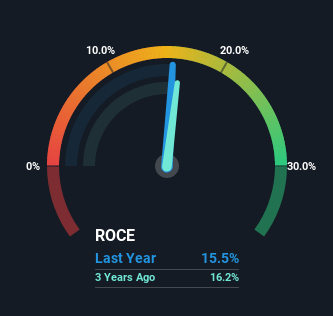- Switzerland
- /
- Machinery
- /
- SWX:SRAIL
Slowing Rates Of Return At Stadler Rail (VTX:SRAIL) Leave Little Room For Excitement
If we want to find a potential multi-bagger, often there are underlying trends that can provide clues. Firstly, we'd want to identify a growing return on capital employed (ROCE) and then alongside that, an ever-increasing base of capital employed. This shows us that it's a compounding machine, able to continually reinvest its earnings back into the business and generate higher returns. So, when we ran our eye over Stadler Rail's (VTX:SRAIL) trend of ROCE, we liked what we saw.
Return On Capital Employed (ROCE): What Is It?
For those who don't know, ROCE is a measure of a company's yearly pre-tax profit (its return), relative to the capital employed in the business. Analysts use this formula to calculate it for Stadler Rail:
Return on Capital Employed = Earnings Before Interest and Tax (EBIT) ÷ (Total Assets - Current Liabilities)
0.16 = CHF216m ÷ (CHF4.4b - CHF3.0b) (Based on the trailing twelve months to June 2022).
Thus, Stadler Rail has an ROCE of 16%. In absolute terms, that's a pretty normal return, and it's somewhat close to the Machinery industry average of 17%.
View our latest analysis for Stadler Rail

Above you can see how the current ROCE for Stadler Rail compares to its prior returns on capital, but there's only so much you can tell from the past. If you'd like to see what analysts are forecasting going forward, you should check out our free report for Stadler Rail.
What Can We Tell From Stadler Rail's ROCE Trend?
While the current returns on capital are decent, they haven't changed much. The company has employed 40% more capital in the last four years, and the returns on that capital have remained stable at 16%. 16% is a pretty standard return, and it provides some comfort knowing that Stadler Rail has consistently earned this amount. Stable returns in this ballpark can be unexciting, but if they can be maintained over the long run, they often provide nice rewards to shareholders.
On a separate but related note, it's important to know that Stadler Rail has a current liabilities to total assets ratio of 68%, which we'd consider pretty high. This effectively means that suppliers (or short-term creditors) are funding a large portion of the business, so just be aware that this can introduce some elements of risk. While it's not necessarily a bad thing, it can be beneficial if this ratio is lower.
Our Take On Stadler Rail's ROCE
The main thing to remember is that Stadler Rail has proven its ability to continually reinvest at respectable rates of return. However, despite the favorable fundamentals, the stock has fallen 39% over the last three years, so there might be an opportunity here for astute investors. For that reason, savvy investors might want to look further into this company in case it's a prime investment.
Like most companies, Stadler Rail does come with some risks, and we've found 3 warning signs that you should be aware of.
If you want to search for solid companies with great earnings, check out this free list of companies with good balance sheets and impressive returns on equity.
New: Manage All Your Stock Portfolios in One Place
We've created the ultimate portfolio companion for stock investors, and it's free.
• Connect an unlimited number of Portfolios and see your total in one currency
• Be alerted to new Warning Signs or Risks via email or mobile
• Track the Fair Value of your stocks
Have feedback on this article? Concerned about the content? Get in touch with us directly. Alternatively, email editorial-team (at) simplywallst.com.
This article by Simply Wall St is general in nature. We provide commentary based on historical data and analyst forecasts only using an unbiased methodology and our articles are not intended to be financial advice. It does not constitute a recommendation to buy or sell any stock, and does not take account of your objectives, or your financial situation. We aim to bring you long-term focused analysis driven by fundamental data. Note that our analysis may not factor in the latest price-sensitive company announcements or qualitative material. Simply Wall St has no position in any stocks mentioned.
About SWX:SRAIL
Stadler Rail
Through its subsidiaries, engages in the manufacture and sale of trains in Switzerland, Germany, Austria, Western and Eastern Europe, the Americas, the CIS countries, and internationally.
High growth potential with adequate balance sheet.
Similar Companies
Market Insights
Community Narratives



